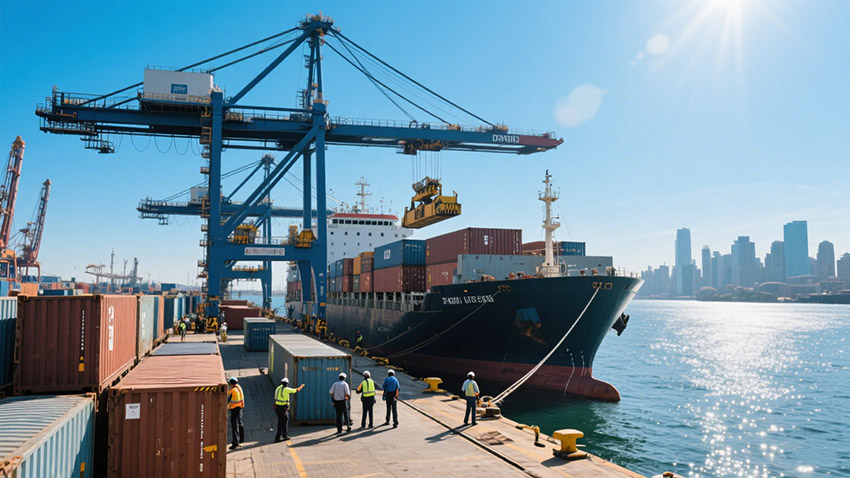In today’s globalized business environment, cross – border logistics efficiency has become a key component of the core competitiveness of B2B foreign trade enterprises. According to industry research data, for every 10% improvement in logistics efficiency, customer repurchase rate can increase by 8%, and the order fulfillment cycle can be shortened by 12%. For B2B foreign trade enterprises, improving cross – border logistics efficiency by 50% is not an unattainable dream, but a goal that can be achieved through the collaborative operation of scientific warehousing management, efficient transportation planning, and professional procurement services. This article will deeply analyze the successful experiences in practical cases and provide enterprises with directly implementable “efficiency improvement secrets”.
Warehousing Management: The Efficiency Cornerstone of Cross – border Logistics
As a hub node of cross – border logistics, the operational efficiency of warehousing directly determines the speed of goods turnover. An electronic component foreign trade enterprise compressed the order processing time from 48 hours to 24 hours through warehouse transformation, and the overall logistics cycle was shortened by 30%. This significant achievement benefited from the following three strategies:
Intelligent zoning planning is the basis for improving warehousing efficiency. Traditional warehousing often leads to lengthy picking time due to mixed categories, while a scientific zoning model should follow the principle of “dynamic classification + turnover rate correlation”. Products with a monthly turnover rate of more than 50 times are placed in the golden area within 3 meters from the shipping port, regular products with a turnover rate of 10 – 50 times are arranged in the middle area, and slow – moving products with a turnover rate of less than 10 times are placed in the farther storage area. At the same time, the “ABC classification method” is used for refined management of products. Class A high – value products are set up in a separate constant – temperature warehouse area with an intelligent monitoring system, Class B standard products are stored on high – level shelves, and Class C low – value consumables are stacked on the ground. This zoning method shortened the picking path of a lamp foreign trade enterprise by 40% and reduced the misdelivery rate from 3% to 0.5%.
The application of a digital inventory management system is the core of efficient warehousing operations. Manually entering inventory data is not only time – consuming and labor – intensive but also prone to errors, while a complete WMS (Warehouse Management System) can realize real – time visualization of inventory. The system should have an automatic early warning function. When the inventory of a certain product is lower than the safety threshold, it will immediately push a replenishment reminder to the purchasing department; at the same time, it supports multi – dimensional inventory query, which can quickly retrieve according to conditions such as SKU, batch, and shelf life. After a household goods foreign trade enterprise introduced WMS, the inventory counting efficiency increased by 60%, and the proportion of slow – moving inventory decreased from 15% to 8%.
The layout of cross – border forward warehouses is a key measure to shorten the end – delivery time. Enterprises can set up forward warehouses in key overseas regions according to the order density of the target market, and stock high – frequency sales products in advance in the forward warehouses, which greatly shortens the time from goods out of the warehouse to delivery to customers. For example, 3C products sold to Europe can have their forward warehouse in Hamburg, Germany, covering the 72 – hour delivery service in 27 EU countries; for the North American market, warehouses can be set up in Los Angeles on the west coast and New York on the east coast of the United States to achieve 48 – hour delivery in the mainland of the United States. An outdoor products enterprise shortened the delivery time in the region from 15 days to 3 days by laying out 3 forward warehouses in Southeast Asia, and customer satisfaction increased by 40%.
Transportation Management: Building an Efficient Cross – border Logistics Network
As a bridge connecting warehousing and customers, the efficiency improvement of the transportation link needs to be promoted from three dimensions: route planning, capacity integration, and visual tracking. A mechanical parts foreign trade enterprise shortened the trans – Pacific transportation time from 35 days to 21 days by optimizing the transportation scheme, and the logistics cost of a single ticket of goods was reduced by 18%.
The multimodal transport combination strategy can give full play to the advantages of different transportation modes and achieve a balance between time efficiency and cost. For urgent orders, the mode of “air transport + overseas warehouse delivery” can be adopted. For example, goods from China to Europe can arrive in Amsterdam, the Netherlands, by air in 2 days, and then be delivered to customers in various European countries by special vehicles from the overseas warehouse, with the whole time controlled within 5 days; for large – batch regular orders, “sea transport + railway” combined transport can be chosen. Goods from China to Europe arrive in Malaszewicze, Poland, via the China – Europe Railway Express in 15 days, and then are transported to various parts of Europe by road, which is 20 days faster than pure sea transport. An auto parts enterprise reduced the annual transportation cost by 25% and increased the on – time delivery rate to 98% by flexibly using multimodal transport.
Capacity resource integration is an important means to improve transportation efficiency. Enterprises can establish their own capacity pool, integrate high – quality resources of international freight forwarders, shipping companies, and truck companies, and flexibly allocate capacity according to the needs of different routes. At the same time, signing long – term cooperation agreements with capacity providers can not only obtain more preferential prices but also ensure capacity supply during the logistics peak period. A chemical products foreign trade enterprise achieved 100% capacity guarantee rate during the peak season by integrating 10 core capacity suppliers, and the transportation scheduling response time was shortened from 48 hours to 8 hours.
The visual logistics tracking system can effectively improve the controllability of the transportation process. By installing GPS tracking devices on the goods and combining with the logistics management platform, both customers and enterprises can check the location, status, and estimated arrival time of the goods in real – time. The system should also have an abnormal early warning function. When the goods are delayed or deviate from the route, it will immediately send a reminder to the relevant personnel so that timely countermeasures can be taken. After a medical device enterprise introduced the visual tracking system, the efficiency of handling abnormal goods increased by 50%, and the customer complaint rate decreased by 35%.
Product Procurement Services: Optimizing Logistics Efficiency from the Source
As the starting point of cross – border logistics, the service quality of product procurement directly affects the efficiency of subsequent warehousing and transportation. Professional procurement services can help enterprises realize “purchasing according to sales”, reduce inventory backlog, shorten the procurement cycle, and thus improve the overall logistics efficiency.
The formulation of a precision procurement plan is the core content of procurement services. The purchasing department should formulate a scientific procurement plan based on sales data, market trends, and customer needs to avoid inventory backlog or shortage caused by blind procurement. By establishing a sales forecast model, combining historical sales data, seasonal factors, and marketing plans, predict product demand 3 – 6 months in advance to provide data support for procurement decisions. A toy foreign trade enterprise shortened the procurement cycle by 30% and increased the inventory turnover rate by 25% through a precision procurement plan.
Supplier management is crucial to the quality of procurement services. Enterprises should establish a sound supplier evaluation system, regularly assess suppliers in terms of product quality, price, delivery time, after – sales service, etc., and select high – quality long – term partners. Establish a strategic cooperative partnership with high – quality suppliers, sign a VMI (Vendor Managed Inventory) agreement, and the supplier is responsible for maintaining a reasonable inventory level. Enterprises only need to settle according to the actual consumption, which greatly reduces the inventory pressure. An electronic equipment enterprise increased the on – time delivery rate of purchase orders from 80% to 95% and reduced the purchase cost by 12% by optimizing supplier management.
China Sourcing Agent: A Logistics Efficiency – enhancing Partner for Foreign Trade Enterprises
As a bridge connecting domestic suppliers and foreign purchasers, China sourcing agents can provide B2B foreign trade enterprises with a full range of procurement and logistics solutions to help enterprises improve cross – border logistics efficiency.
One – stop procurement service is the core advantage of China sourcing agents. Agent companies have rich supplier resources and procurement experience, and can provide enterprises with full – process services from product selection, price negotiation, quality inspection to logistics arrangement. Enterprises can efficiently complete procurement work through sourcing agents without setting up a procurement team in China, saving manpower and time costs. A European furniture retailer shortened the procurement process from 2 months to 2 weeks and reduced the procurement cost by 15% by cooperating with a China sourcing agent.
Supply chain collaboration capability is an important characteristic of excellent China sourcing agents. Sourcing agents can coordinate resources in various links such as suppliers, warehousing, and transportation to ensure that purchased products are delivered on time, in quality, and in quantity. In case of supply chain fluctuations, sourcing agents can quickly adjust procurement plans and logistics schemes to ensure the stability of the supply chain. For example, during the epidemic, a China sourcing agent urgently allocated medical supplies for overseas customers. By coordinating multiple suppliers and logistics channels, the procurement and transportation cycle, which originally took 10 days, was shortened to 3 days, solving the urgent need for customers.
Practical Case: The Path of Time Efficiency Improvement of a B2B Foreign Trade Enterprise
A hardware tools foreign trade enterprise once faced the problems of long cross – border logistics time and many customer complaints. By implementing the above optimization schemes for warehousing, transportation, and procurement, it achieved a significant improvement of 50% in logistics efficiency within 1 year. The following is its specific implementation path:
In terms of warehousing, the enterprise re – planned the original warehouse, divided it into a best – selling area, a regular area, and a slow – moving area, introduced the WMS system to realize real – time inventory management, and set up forward warehouses in Germany and the United States, shortening the delivery time in the European and North American markets from 18 days and 25 days to 5 days and 7 days respectively.
In the transportation link, the enterprise integrated resources of 5 shipping companies, 3 air freight companies, and 10 overseas truck companies to establish a multimodal transport network and flexibly choose the transportation mode according to the urgency of orders. For urgent orders, the “air transport + overseas warehouse delivery” mode is adopted; for large – batch orders, the “sea transport + railway” combined transport is adopted, and the transportation cost is reduced by 22%.
In terms of procurement services, the enterprise cooperated with a professional China sourcing agent, which was responsible for the screening, procurement, and quality inspection of domestic suppliers. The procurement cycle was shortened from 45 days to 20 days, and the inventory turnover rate was increased by 35%.
Through the collaborative implementation of a series of measures, the cross – border logistics time of the enterprise was shortened from an average of 40 days to 20 days, the customer repurchase rate increased by 30%, and the annual sales increased by 25 million yuan.
Conclusion: Opening a New Chapter in Cross – border Logistics Efficiency Improvement
The improvement of cross – border logistics efficiency is a systematic project that requires close cooperation between warehousing, transportation, and procurement. B2B foreign trade enterprises should formulate personalized logistics optimization schemes according to their own product characteristics and target markets, and continuously improve logistics efficiency and reduce operating costs through intelligent and digital management means to gain an advantage in the fierce international market competition.
In the future, with the continuous development of cross – border e – commerce and the continuous innovation of logistics technology, there is more room for improvement in cross – border logistics efficiency. Enterprises should maintain a keen market insight, actively embrace new technologies and new models, continuously optimize the logistics system, provide more efficient and high – quality logistics services for customers, and realize the sustainable development of enterprises.










Leave a Reply